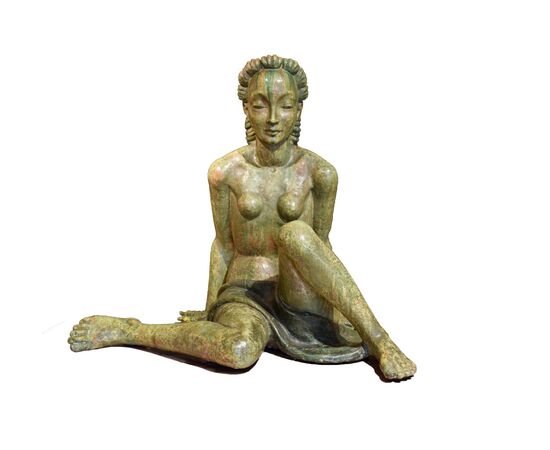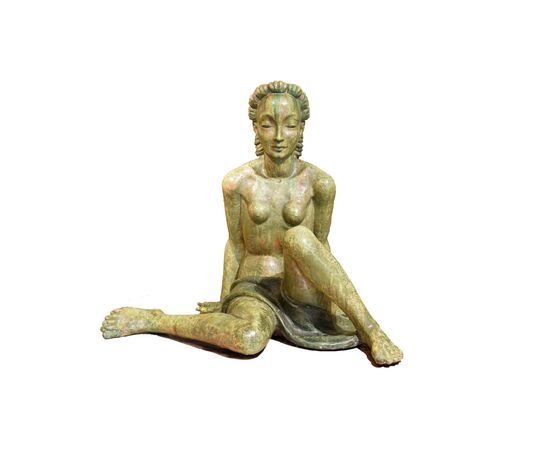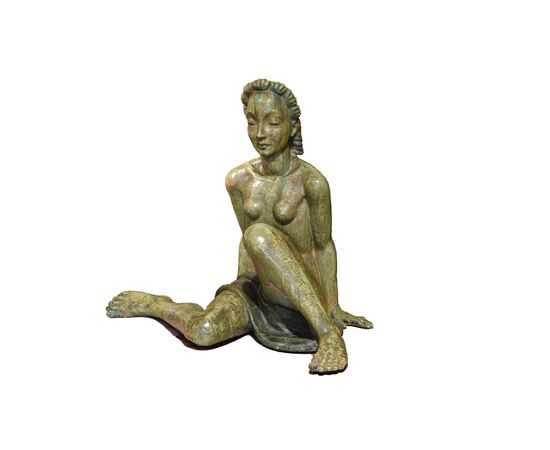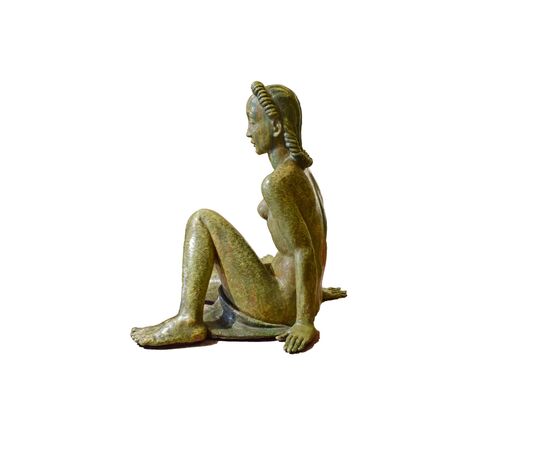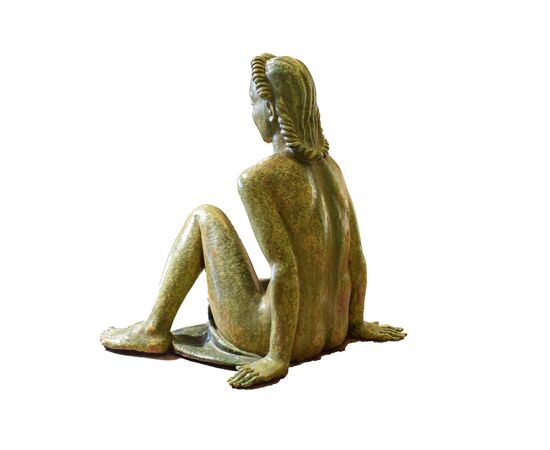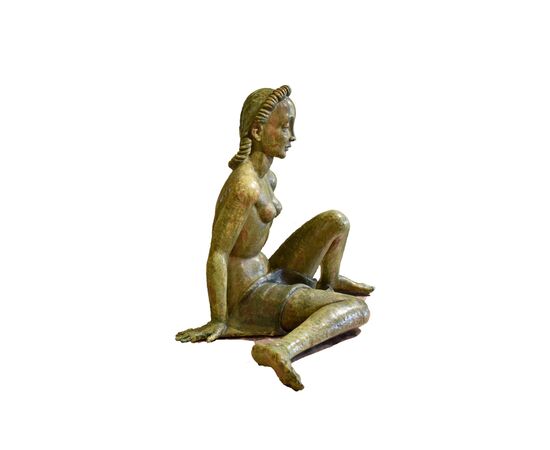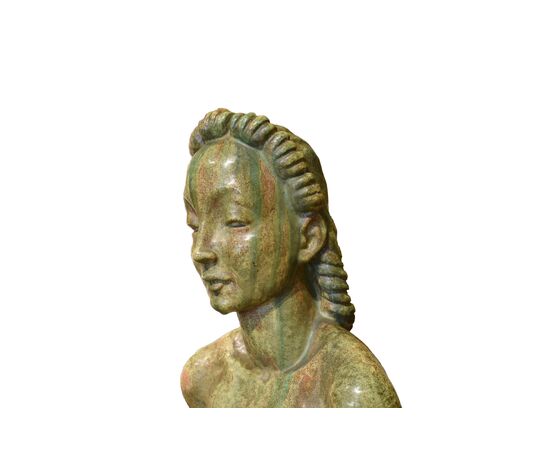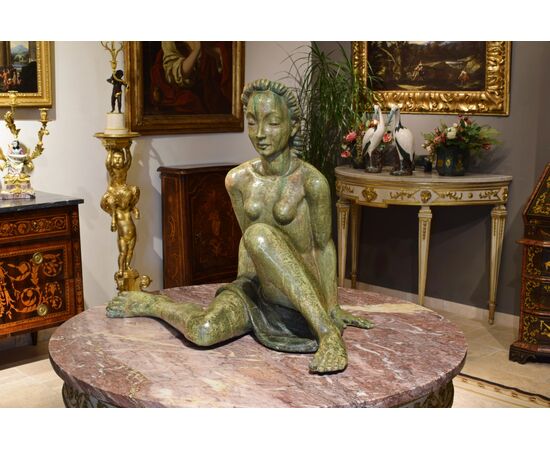Glazed terracotta sculpture, Lenci manufacture based on a model by Helen König Scavini, Nude, circa 1927-36
Lenci manufacture based on a model by Helen König Scavini, Nude
Glazed terracotta, dimensions: H 70 cm x Front width 83 cm (Rear width 55 cm) x D 55 cm
Brush-signed under the base "Lenci/Italy"
Price: private negotiation
Item accompanied by a certificate of authenticity and expertise (attached at the bottom of the page)
The valuable sculpture, made of glazed terracotta, is the work of the famous Lenci manufacture of Turin based on a model by Helen König Scavini. Of considerable size, it depicts a nude woman, covered only by a cloth at the waist, sitting with her legs bent asymmetrically while supporting herself on her arms with her hands resting on the surface. The woman has a hieratic expression, large arched eyebrows under which her ethereal eyes are half-closed; her parted lips conceal a hint of a smile. Her loose hair is turned back with large waves both on her head and down her back. The coloring of the glazing is in shades of moss green, which contributes to giving this woman the appearance of a nymph or a mythological figure. Underneath the terracotta base is the hand-painted mark of the manufacture "Lenci, ITALY".
The Lenci brand was registered in Turin on April 23, 1919, sanctioning an activity undertaken some time earlier by Helen König, wife of the sales agent Enrico Scavini. The origin of the term Lenci is still controversial today; the earliest bibliography says it is derived from a diminutive of Elena (Elenchen, as her father called her and which she, mangling it, pronounced Lenci), while the more recent one considers the acronym Ludus Est Nobis Costanter Industria, perhaps invented by Ugo Ojetti or constructed as a divertissement by the poet Ignazio Vacchetti (alias Fantasio) on the diminutive of Elena. The Lenci factory became a meeting point for artists and a breeding ground for ideas for the development and production of dolls and puppets, children’s furniture, and later also artistic ceramics. The first artists to take an active part in the company were Giovanni Riva and Sandro Vacchetti, soon joined by other big names. The success of these felt dolls earned the Lenci company numerous awards during international exhibitions in Zurich, Paris, Rome, or Milan. However, the originality of Lenci’s creations was soon tested by numerous imitations. To counter this type of competition, Lenci began producing artistic ceramics, the activity of which began in 1927. The ceramic figures became perhaps even more famous than the cloth dolls. The subjects ranged from the famous “nudes,” to fashionable and emancipated young ladies, from fantasy characters to animals, from religious images to the most disparate vases and much more.
Numerous artists collaborated in the creation of the models, among whom it is worth mentioning the aforementioned Sandro Vacchetti, artistic director of Lenci from 1922 to 1934, Elena König Scavini herself, Cläre Burchart, Lino Berzoini, Giovanni Riva, Giovanni Ronzan, Teonesto Deabate, Giovanni Pietro Spertini, Marcello Dudovich, Gigi Chessa, Mario Pompei, Nillo Beltrami, Mario Sturani, Giulio Da Milano, Giovanni Grande, Ines Grande, Claudia Formica, Luigi Borione, Camillo Ghigo, Giuseppe Porcheddu, Gino Levi-Montalcini, Abele Jacopi. Magazines of the time testify to the artistic value of Lenci ceramics: from the magazine “Domus” to “Casa Bella”, the constant publication of Lenci ceramics demonstrates the desire to establish itself with a selected, cultured, and refined public. Contributing to its success was participation in the reviews of the time, from the International Exhibition of Decorative Arts held in Monza in 1923, to the International Exhibition in Paris in 1925, to the National Exhibition of 1928 in Turin. In December 1929, the Galleria Pesaro in Milan exhibited 95 works, accompanied by a lengthy presentation by the art critic Ugo Ojetti and testifying to the activity of almost all the artists working for the Scavini family. The Lenci’s presence at the IV International Exhibition of Modern Decorative and Industrial Arts in Monza in 1930 followed, which garnered a dizzyingly positive judgment.
The great appreciation of critics and the attention of specialized magazines did not save Lenci from the crisis in international markets. In 1933, some corporate shares were sold to the Garella family, and in 1934 Sandro Vacchetti left the artistic direction of the manufacture to found his own, Essevi. He was succeeded by Mario Sturani, who remained until 1964, when the production of ceramics was interrupted. In 1937 the Garellas acquired all the corporate shares of Lenci, maintaining artistic direction under Elena König, who left the position in 1941, after the death of her husband (1939). In 1992, Lenci Srl was sold to two new companies: the production sector (machinery and equipment in general) passed to Bambole Italiane Srl, which went bankrupt in 2002, while the trademarks and patents were sold to WestBay Servicos e Investimentos of Madeira (Portugal), which continues to operate regularly today.
Today, the historic Lenci ceramics and dolls are sought-after collector's items exhibited in museums around the world. With Lenci in Turin, what manifested itself in the same years in Danish figured porcelain and Viennese ceramics of the Wiener Werkstaette took place: the perfectly successful attempt was to produce ceramics that had behind them the design of an artist. The ceramic work therefore became a work of art in itself, influenced by the artistic and cultural currents of the time.
The working processes within Lenci are complex and of great refinement. The sketches of the ceramics are generally drawings in watercolor, tempera, or pastels. For the realization of the ceramics, the methods varied depending on the artist. A model was made in plasticine and then entrusted to the molder to obtain a negative matrix. From the matrix, a few copies of the prototype were obtained and then decorated under and overglaze by the most experienced painters under the control of the authors of the model. Based on the success of these first specimens, it was decided whether to put the object into production. The preparation of the plaster constituted the starting point of production, which could also be interrupted at that stage. The assignment of the model number to the plaster is a sure indication of the start of its production: it gave the physical location of the plaster itself in the room intended for molding. The ceramic inherited the model number assigned to the plaster, proposed incised (i.e. signatures, initials, monograms, and numerical combinations) on individual specimens only from a certain moment onwards in production. There were also the methods of brush marking and incised signing of the ceramics, connected to distinct chronological moments. The writing Lenci/Italy is among the very first tests, datable between 1927 and 1928.
Of the sculpture under study, there exists a numbered plaster model, of smaller dimensions, from which some ceramics have been derived, also of dimensions similar to those of the other Lenci porcelains intended as ornaments. The inventory allows us to identify the author of the subject, Helen König Scavini, and the title, namely “Nuda”. The numbering of the model, 803, allows us to date the model between the years 1931 and 1936, among which the examples from 421 to 1160 were cataloged.
Our sculpture, being of large dimensions, could be a prototype, a study by Elena to which the subsequent small productions followed. It can be hypothesized that it may therefore have been made between 1927 (due to the writing underneath) and 1936 (due to the numbering of the model).
It should also be noted that there is another version of the terracotta with the Nuda, gilded, used as an exhibition model for a manufacturer of silk scarves that interprets the design of the historic Lenci wrapping paper, designed by Gigi Chessa. There is no mention of any information about the sculpture; however, from the image it is possible to deduce that it is of comparable dimensions to the one studied here.
Helen König was born in Turin on February 28, 1886, to an Austrian mother and a German father. The family had moved to the Piedmontese capital in 1885, but her father died very young, leaving the family in serious economic difficulties. Her rich personality, intellectual vivacity, and particular predisposition for art in its various representations led her to travel extensively in Europe. In 1907 she obtained a diploma as a master photographer in Düsseldorf and there she met Clare Burchart, a collaborator for the Rosethal porcelain factory, who brought her closer to the world of modeling. The friend became fundamental in 1928 when she was called to collaborate in Turin to provide her excellent experience. From 1915 Helen returned to Turin, where she met and married Enrico Scavini.
Helen’s eclectic personality, with its Central European background and unbridled curiosity, is catalyzing for bringing together a circle of artists progressively involved in the creation of a true artistic world. The success of her dolls became planetary, decreeing the affirmation of the Lenci name throughout Europe and in America. Hers are beautiful ladies who have come out of the more or less scantily clad cinematographic imagination; Helen designs scenes inspired by mythology or devotion, children or animals portrayed in amusing and improbable poses.
Helen König Scavini’s style is clearly evident in the Nuda sculpture. The way she interprets the feminine anatomy, the woman’s pose, and the facial features can be found in many of her other works. In particular, the woman’s head is very close to the many ceramics that Helen designs depicting the nymph Calypso. These are female heads styled similarly and with assimilable facial features, although they have some slight variations.
In conclusion, the sculpture under study represents a significant manifestation of Helen König Scavini’s artistic expression, created in the central years of her greatest notoriety, between 1927 and 1936. A work that could be considered a masterpiece of the artist, certainly of considerable interest, which is added to the corpus of works by König Scavini and the great Turin manufacture Lenci.
Carlotta Venegoni

